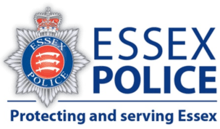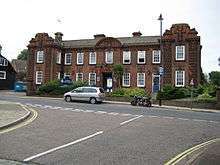Essex Police
| Essex Police | |
|---|---|
|
Logo of the Essex Police | |
| Motto | Protecting and serving Essex[1] |
| Agency overview | |
| Formed | 1840 (as Essex Constabulary), 1969 |
| Preceding agencies |
|
| Employees | 3,200[2] |
| Volunteers | 400[2] |
| Annual budget | £262.5 million[2] |
| Legal personality | Governmental: Government agency |
| Jurisdictional structure | |
| Operations jurisdiction* | Police area of Essex in the country of England, UK |
.svg.png) | |
| Map of police area | |
| Size | 1,400 square miles |
| Population | 1,780,000 residents |
| Legal jurisdiction | England and Wales |
| Constituting instrument | Police Act 1996 |
| General nature | |
| Operational structure | |
| Headquarters | Springfield, Chelmsford |
| Police Constables | 2,894 (additionally 372 are special constables)[3] |
| Police Community Support Officers | 219[2] |
| Police and Crime Commissioner responsible | Nick Alston |
| Agency executive | Stephen Kavanagh, Chief Constable |
| Basic Command Units |
South West North London Stansted Airport |
| Police Stations | 12 |
| Facilities | |
| Boats | 3 |
| Helicopters | 1 |
| Dogs | 40 |
| Website | |
| www.essex.police.uk | |
| Footnotes | |
| * Police area agency: Prescribed geographic area in the country, over which the agency has usual operational jurisdiction. | |
Essex Police is a territorial police force responsible for policing the county of Essex in the east of England.
It is one of the largest non-metropolitan police forces in the United Kingdom, employing approximately 3,000 police officers and operating across an area of over 1,400 square miles (3,600 km2) and with a population of around 1.7 million people.
The Chief Constable is Stephen Kavanagh[4] since May 2013.
Assistant Chief Constable for Media Relations Steve Worron is also simultaneously ACC for Area Operations for Kent Police due to the two forces forming a joint Serious Crime Directorate.[5]
In November 2012, the first ever Essex Police and Crime Commissioner election took place, in which Conservative candidate Nick Alston achieved 30.5% of the first round votes, and 51.5% of the second round votes against Independent candidate Mick Thwaites. [6] Alston set his 4 priorities in his election statement[7] as 1) policing that meets local needs, 2) policing that is prompt and professional, 3) effective cooperation and partnership between Police, Councils and the Voluntary Sector, and 4) to be an influential voice in leading public engagement about crime reduction and policing, and to listen to and speak for the victims of crime. Nick Alston was elected with a 12.8% turnout.[8]
History
Essex Constabulary was formed in 1840. In 1965, the force had an establishment of 1,862 officers.
Southend-on-Sea Borough Police was established by the county borough of Southend-on-Sea, England, in 1914. In 1969 Southend-on-Sea Borough Police amalgamated with Essex Constabulary to become the Essex and Southend-on-Sea Joint Constabulary. This merger was campaigned against by the council and the local MPs.[9] Colchester also at one time had its own police force.
The title was shortened to Essex Police in 1974. In April 2000, it took over parts of the county in the south-west (Loughton, Waltham Abbey, Chigwell and Buckhurst Hill) formerly in the Metropolitan Police Area.
Epping Forest Keepers act as Epping Forest constables in the Forest parishes in the south-west of the Essex Police area; they have different powers from those of the Essex Police.
Organisation
Essex Police is one of the United Kingdom's largest non-metropolitan police forces with a strength of approximately 3,000 police officers.
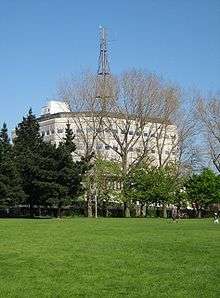
Its headquarters, the Force Control Room (where emergency calls are routed to) and Essex Police College, are all located in Chelmsford.
Strategically, Essex is an important force. Bordering London, the force area consists of affluent city suburbs, large urban areas, industrial centres, rural villages, London Stansted Airport (one of the busiest international airports in the country) and two of the UK's major ports (Harwich and Tilbury). The force also polices one of the largest expanses of coastline of any force in the UK. The police area covers 1,400 square miles (3,600 km2) and has a population of around 1,600,000.
The Chief Constable is Stephen Kavanagh who replaced Jim Barker-McCardle in May 2013.
The force has been a regular innovator and is often used by the Home Office to trial new procedures and equipment, including automatic number plate recognition (ANPR), Lantern (handheld wireless fingerprint verification) and the X26 Taser.
Essex Police was also the subject of the television series Police Interceptors, which followed the work of the specialist Mobile Support Division's ANPR intercept unit that utilise high-performance pursuit vehicles, including the Mitsubishi Evo X and Subaru Impreza, to pursue and intercept mobile criminals.
Previously a number of specialist teams within Essex were grouped into the Mobile Support Division. In 2012 Essex Police moved away from the divisional structure to a patrol based structure and the former components of the Mobile Support Division were moved to new command structures. Roads Policing and Dog Section became part of the Response and Patrol function
Crime Division
Crime Division works across the territorial divisions of Essex and with forces nationwide, providing resources and expertise.
As a division within Essex Police, it deals with the specialist aspects of crime investigation, tending to focus on serious crime, but not exclusively and provides support to territorial divisions' efforts in investigating crime.
Crime Division has a command team structure of a divisional commander, supported by a director of intelligence, lead senior investigating officer, support manager and divisional administrative manager, based at the Chelmsford headquarters. This team is supported by section heads. The work of the various departments of Crime Division are both proactive and reactive.
Major Investigation Team
The way in which major crimes are investigated has changed over time. 30 years ago, the head of Crime Division would have carried out every part of the investigation in a murder case himself, including interviewing key witnesses. However, this has now been transformed with the advent of computerised Major Investigation Rooms and concerns over handling complex, high-profile enquiries like the Stephen Lawrence case.
In April 2000, the Major Investigation Team (MIT) was set up to investigate homicides, abductions, rapes and extortion. Each major investigation has a senior investigation officer (SIO), who is like the conductor of an orchestra, overseeing all the different parts of the investigations. The SIO works with a MIT and they are supported by the resources of Major Investigation Centralised Administrative Support (MICAS).
There are four MIT offices, at Harlow, Brentwood, Stanway and Rayleigh. The scale of enquiry determines the manpower required, the well-publicised case of the murdered schoolgirl Danielle Jones in June 2001 being a good example of the four offices 'pooling' resources and working as one team.
Operations Support Group
The OSG are members of Essex Police trained to deal with riots, drugs raids, other public order incidents, escorting suspects to be extradited to other countries, CRBN, and evacuation in the event of CRBN attack. They are the equivalent of the Met's TSG unit. They were involved in President Obama's landing at Stansted in 2016. They helped the Met deal with the 2011 London Riots. They drive Volkswagen Crafter vans, as well as Mercedes Sprinters, and BMW 525D estates; they have access to some of the fastest cars in the force. They are based at Boreham. They carry X26 Tasers, Speedcuffs, and the usual CS:Spray and Baton.
Force Support Unit (FSU)
The FSU provide firearms and tactical assistance. They respond to firearms callouts, help out with drug raids, as well as taking part in covert operations. They drive BMW X5s, BMW 525D estates, Volvo V70 estates, and in addition to this, a Ford F150 Jankel, similar to that of the neighbouring Metropolitan Police, is on hand. Like the OSG, they are based at Boreham. The FSU officers are all AFOs and SFOs. They patrol Stansted Airport, and in September 2016, armed patrols started at Southend Airport and Lakeside shopping centre. They carry G36 rifles, as well as Carbine rifles, and Glock 17s. They will either be wearing baseball caps on patrol, or the "Fritz" style helmet for tactical duties. The FSU shot Stephen Debley, the first person to be shot by Essex Police for 31 years as of October 2016. They have also been involved in many manhunts, the most well known and recent being the death of PC Dibell, who was shot by 63-year old Peter Reeve in Clacton on Sea. As with the OSG and the Air Support Unit, they are based at Boreham, on the outskirts of Chelmsford.
Special Branch
The Special Irish Branch was formed in 1883 by the Metropolitan Police, to deal with Irish Republican activists in London. This extremely secret unit consisted of a handful of detectives whose offices were located in a wooden hut on an island within Green Park, just behind the old Scotland Yard. The unit later took on the role of reporting to the Security Service (MI5) and quickly became recognised as 'The Special Branch'.
Essex Special Branch was formed in 1970 when the Security Service required an input from all provincial police forces.
Special Branch (SB) deals with any matters which may involve any form of subversive activity, such as terrorism, which may affect either life or property nationally or internationally. The air and seaports are specific areas where SB officers operate to ensure that those involved in internal and/or external acts of terrorism are prevented from entering or leaving the country.
SB also maintains close contacts with other police services, both within the UK and abroad, to exchange information on persons who are known or believed to be involved in terrorist activity.
On the domestic front SB combat public disorder by dealing with those involved in extreme activity of any description. Special Branch workload has increased exponentially in the years following the September 11 attacks and 7 July 2005 London bombings. Much of what SB does is highly sensitive, involving national security, and goes unnoticed by the general public.
SB officers are also tasked and trained in armed, close protection duties and work to protect royalty, VIPs and anyone else who could be under threat of attack or assassination, whilst in the Essex Police District.
Serious Crime Division
The Serious Crime Division (SCD) consists of a team of highly experienced detectives who are involved in investigating serious and organised crime inside and outside of the Essex police area. The work of the SCD is centrally coordinated to prioritise crimes and locations that will have most effect on the overall performance of the force. The unit also utilise mobile surveillance teams. Day-to-day business for the SCD includes investigations into serial crimes, such as burglary, car crime and robbery, where criminals cross multiple borders to commit crime.
Economic Crime Unit
The Economic Crime Unit (ECU) is part of SCD and is based at Brentwood. The ECU is made up of detective officers and accredited civilian financial investigators, whose work is overseen by a detective inspector.
The ECU has two distinct but overlapping functions. The first is the investigation of serious and complex fraud. Referrals to the ECU are from other agencies, such as the Department for Business, Serious Fraud Office and Office for the Supervision of Solicitors. The ECU will also take on investigations referred to it by territorial divisions, subject to certain criteria having been met. The unit does not normally accept investigations directly from members of the public.
The second function is the confiscation and/or forfeiture of assets held by persons convicted of drug trafficking offences. With the arrival of the Proceeds of Crime Act 2002 and the government's determination to be more proactive in this area the scope of confiscation and/or forfeiture has increased to include criminal offences of an acquisitive nature.
Hi-Tech Crime Unit
The Hi-Tech Crime Unit deals with computer crime and the use of computers in committing crimes. Offences may include harassment, theft, hacking, phone phreaking (making telephone calls which are then charged to another person's bill) and child pornography.
Many of these are new crimes, which have only appeared since the widespread availability of computers and the Internet. The Hi-Tech Crime Unit is a relatively new addition to policing in Essex and forms part of a national network of agencies fighting against computer crime, headed by the National Hi-Tech Crime Unit based in London Docklands.
Essex Police's Hi-Tech Crime Unit works closely with other network investigators and law enforcement agencies. Although it has been in existence only a short time, the unit has already seen significant results. Part of the work of the unit involves seizing computer-related evidence and using forensic methodology software. Officers have the ability to interrogate the seized computer, even when information has been deleted, and rebuild it to find out what was done and how. The unit also assists police officers in computer-related cases, particularly with conducting interviews or producing technical statements, and produces evidence for court.
The unit is staffed by internationally trained computer specialists, who keep up-to-date with the latest changes in technology and software. They are also able to advise businesses of the danger of computer crime, particularly in e-commerce.
Authorities Bureau
The Authorities Bureau was established to oversee all covert policing authorisations. When Essex Police wish to set up surveillance on a suspect, they must make an application to the Authorities Bureau, who decide whether the surveillance is justified and complies with the Regulation of Investigatory Powers Act 2000 which is based on human rights legislation.
The Bureau oversees all applications from each of the territorial divisions. It is staffed by police officers and support staff. The police officers specialise in the area of surveillance authorities, including the more specialist applications which require authority from the Chief Constable. The support staff are based in the Telephone Enquiry Unit and undertake all enquiries made of the numerous telecom industry members. The staff are trained to a national standard and ensure that the enquiries requested are fully justified, correctly authorised and actioned, according to priorities.
The Bureau are inspected annually by the Office of Surveillance Commissioners, an independent body of serving or recently retired High Court judges who report direct to the Prime Minister.
Vetting Unit
The Vetting Unit is responsible for running checks on individuals who regularly have substantial unsupervised access to children up to the age of 16, or 18 if they have special needs or are looked after by a local authority. The information they gather is disclosed to authorised outside agencies and other police services.
The work of the unit includes the vetting of persons who have applied to become foster parents or adoptive parents, registered childminders and managers of residential care homes and nursing homes.
Force Intelligence Bureau
The role of the Force Intelligence Bureau (FIB) is to assist criminal investigation across the county by bringing together local intelligence from different divisions and out of the police area. The FIB collects information on dangerous sex offenders and those criminals whose activities span more than one area of Essex or across counties. They also analyse trends and links between crimes, so that they can use the right people and the right methods in the right places to prevent crime.
Stolen Vehicle Section
The Stolen Vehicle Section of the Force Intelligence Bureau was formed around 1964 to lend assistance and support to police officers in dealing with motor vehicle crime. One of the main functions of the section is the examination and identification of suspect vehicles, plant and other equipment, both by thermal and chemical etching of erased and hidden serial and identification numbers.
After examination, all vehicles identified as stolen by the unit carry a 'Polexam' tamperproof marker. This is placed on a number of locations on the examined vehicle and a marker created on the Police National Computer to indicate that it has been subject of a previous police examination.
The unit were responsible for the implementation of the "decoy vehicle" programme. They are also involved in vehicle crime analysis and attend warrants and briefings where vehicle crime is suspected or known.
Field Intelligence Officers
Area desk Field Intelligence Officers (FIO) are assigned to particular areas of Essex or to liaison with Customs and with other divisions of Essex Police, such as the Drugs and Serious Crime Squad. FIOs are responsible for gathering intelligence on crimes committed in several areas or across area boundaries, so that patterns in these crimes can be analysed.
Criminal Intelligence Analysts
The role of the Criminal Intelligence Analyst is to use all the available information on criminal activity in Essex to assess trends which can be seen now and predict what might happen in the future. The results of this analysis are then passed on to those responsible for making decisions about allocating resources.
Analysts bring together all the information so that they can look for areas where they need more information or focus on particular lines of enquiry.
Dangerous Offenders Unit
The main function of the Dangerous Offenders Unit (DOU) is to manage the threat posed by sex offenders and other potentially dangerous and violent criminals. 'Dangerous offenders' are those people "likely to inflict serious physical or psychological harm on others".
The issue of how to protect the public from dangerous offenders has been vigorously debated since the early 1970s, when a highly publicised homicide case involving a released mental patient led to demands for stronger preventative measures.
The DOU works with the Multi-Agency Public Protection Panel (MAPPP), which co-ordinates intelligence and action to reduce the risk posed to the public by potentially dangerous offenders. MAPPP meetings are led by police, probation and social services, with input from other agencies such as housing and criminal justice mental health teams, depending on the case.
The DOU is also responsible for maintaining the Sex Offenders Register, which came into force under the Sex Offenders Act 1997. All convicted sex offenders must register their name and address with the police and inform them within 14 days if they move.
Facial Identification Officer
The trauma that a stranger may inflict during a serious offence may influence the victim's memory of the suspect's identity. This is when the Facial Identification Officer can assist by using a portable computerised feature and paint package programme in order to put together a 'composite' of the offender. Being portable, it enables the officer to travel to the victim's home or their hospital bed. They will interview the witness or victim using 'cognitive' interview which assists the witness to 'relive' rather than 'remember'. Having ascertained a general description of the offender this is then entered into the E-FIT system. The witness then works with the officer to achieve the best 'likeness' of the offender.
Prison Liaison Section
The Prison Liaison Section provides an interface between the police force and the prison service. They give help and advice to both agencies on obtaining information and intelligence with regard to persons in prison custody.
Fleet
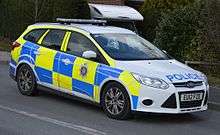
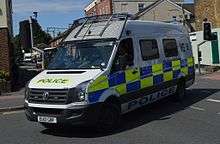
As of 2016, the number of marked Essex Police vehicles in operation:
- 232 Response Units - Used for patrol and emergency 999 response.
- 42 Traffic Units - Used for traffic enforcement: Enforce traffic laws and encourage road safety.
- 25 Prisoner Transport Units - Used for the transportation of suspects from the scene.
- 28 Public Support Units - Used to carry public-order trained officers to the scene.
- 15 Dog Support Units - Used to carry police dogs and handlers to the scene.
- 32 Non-Response Units - Used for patrol, however not emergency response.
- 6 Driver Training Units - Used to train police drivers to respond on blue lights and sirens.
Officers killed in the line of duty
The Police Roll of Honour Trust lists and commemorates all British police officers killed in the line of duty. The Police Memorial Trust since its establishment in 1984 has erected over 38 memorials to some of those officers.
Since 1849 the following officers of Essex Police were killed while attempting to prevent or stop a crime in progress:[10]
- Constable Ian Dibell GM, 2012
- Constable Gary John Veal, 2002
- Constable Roderick Norton Daniels, 2001
- Constable Christopher John Wiggins, 1992
- Acting Sergeant Brian John Bishop, 1984
- Constable Peter James Wringe, 1982
- Constable Brian Arthur Rippingale, 1968
- Sergeant Edmund Sleigh Frost, 1948
- Constable George William Gutteridge, 1927
- Constable Joseph Watt, 1913
- Acting Sergeant Adam John Eves, 1893
- Inspector Thomas Simmons, 1885
- Constable Robert Bamborough, 1850
- Head Constable William Campling, 1849
See also
- Law enforcement in the United Kingdom
- List of law enforcement agencies in the United Kingdom
- Table of police forces in the United Kingdom
Other emergency services:
References
- ↑ essex.police.uk
- 1 2 3 4 police.homeoffice.gov.uk
- ↑ "Tables for 'Police workforce, England and Wales, 31 March 2013". HM Government. Office for National Statistics. 31 March 2013. Retrieved 29 May 2014.
- ↑ "Chief Constable Stephen Kavanagh". Essex Police. Retrieved 29 May 2014.
- ↑ kent.police.uk
- ↑ "Essex police and crime commissioner results". BBC. 19 November 2012. Retrieved 29 May 2014.
- ↑
- ↑
- ↑ "Essex Police".
- ↑ http://www.policememorial.org.uk/index.php?page=essex-police
Bibliography
- The Essex Police by John Woodgate. Includes black and white plates and an appendix section that gives details of the smaller forces that went to make up Essex Police. Detail from a copy published by Terence Dalton in 1985 with an ISBN 0-86138-034-7.
